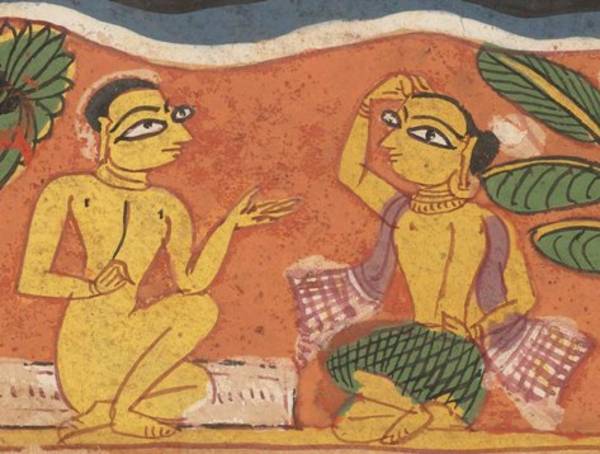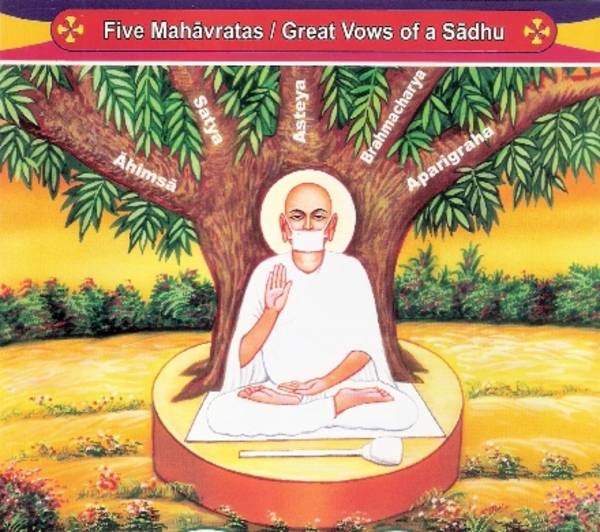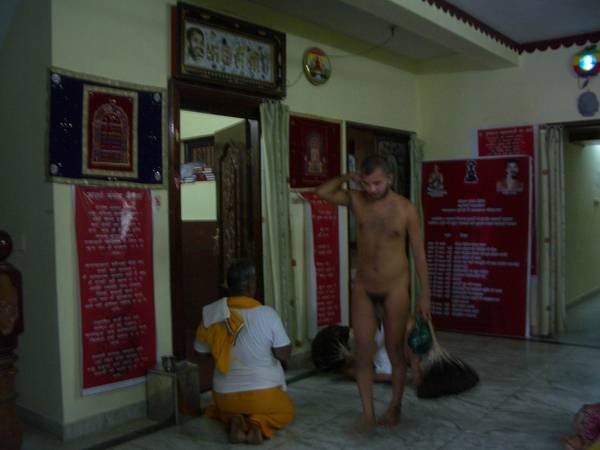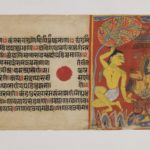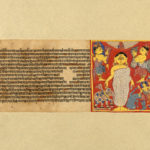Article: Monks and nuns
Monks and nuns are frequently referred to as mendicants or ascetics. Jain mendicants are people who have completed the official initiation ceremony called dīkṣā and live according to monastic rules. They renounce ordinary life, receive the monastic equipment in keeping with the monastic order to which they will belong and after that lead a life observing the ‘five great vows’ – mahā-vrata.
Organised in hierarchies, mendicants also follow the rules of their sect and monastic order. Mendicants belong to one of the two main sects of Śvetāmbara and Digambara. They have strict rules regulating their behaviour and monastic equipment.
In contrast to the Christian concept of monks and nuns, Jain ascetics have a wandering lifestyle most of the time and have daily contact with lay people. This chiefly takes the form of the ritual of seeking alms.
There is a range of terms for Jain mendicants, with the Digambaras and Śvetāmbaras normally using slightly different words for the same concepts. An ordinary monk is known as a muni or sādhu while an ordinary nun is an āryikā for Digambaras and is usually called a sādhvī by Śvetāmbaras.
Monks and nuns form two elements of the traditional fourfold community of Jainism, along with lay men and lay women. The proportion of mendicants to lay people is very small. Nuns always outnumber monks in traditional statistics for the communities founded by the Jinas, at least among Śvetāmbaras. For example, according to the Kalpa-sūtra, the fourfold community which the 24th Jina Mahāvīra established was made up of 14,000 monks, 36,000 nuns, 159,000 lay men and 318,000 lay women. There are fewer nuns than monks among the Digambaras.
Initiation
When a householder decides to become a monk or nun, he or she completes the ritual of renunciation or initiation – dīkṣā. The two main Jain sects of Digambaras and Śvetāmbaras follow somewhat different dīkṣā ceremonies. The various mendicant lineages within the sects also have distinct initiation traditions. There may also be rules regarding the age or caste of the initiate and the individual who may carry out the initiation.
Some elements of the initiation take place in private, others in public rituals. Initiation is considered a celebration for all of the Jain community, lay and mendicant, as well as an opportunity to gain merit – puṇya – for lay Jains.
The most striking aspect of initiation for outsiders is the ritual of keśa-loñca. In this rite, the initiate removes his or her hair. Traditionally, this is pulled out in five handfuls and men also pluck out their facial hair. Nowadays, however, among Śvetāmbara Mūrti-pūjaks usually a symbolic tuft is plucked out and the rest shaved off. The concept of keśa-loñca underlines the ideal ascetic’s indifference to the body and signals a readiness to take on the demands of the mendicant lifestyle.
Among Śvetāmbara Mūrti-pūjaks, some parts of the dīkṣā ceremony are performed in private, some in public. There are ceremonies in the days before and after the day of initiation, usually involving the local lay community.
Among Digambara Jains, becoming a mendicant takes several stages. In the early stages, the individual takes the 11th stage of renunciation – pratimā – of a lay person and remains a householder. Many devout lay people remain at this stage. Those who wish to become mendicants are then initiated and are considered novice mendicants.
Within all sects, the new mendicant is given a new name and completes a period as a kind of novice mendicant. The final initiation into full mendicancy – including the keśa-loñca – is a public ritual for Digambaras and usually a private ceremony for Śvetāmbaras. It entails taking the ‘Five Great Vows’.
The ‘Five Great Vows’
As part of their initiation, monks and nuns swear to follow these ‘absolute’ vows or mahā-vrata:
- non-violence – ahiṃsā
- truth – satya
- non-stealing – acaurya or asteya
- celibacy – brahmacarya
- non-attachment or non-possession – aparigraha.
This is the traditional order in which the vows are listed. They were clearly set out by Māhavīra, the 24th Jina. Earlier, in the time of his predecessor Pārśvanātha or Lord Pārśva, there were only four restraints, with the vow of celibacy included in that of non-possession.
Monks and nuns live according to these vows for the rest of their lives. It is very rare for a mendicant to return to the householder life. Lay people, however, can practise asceticism and take formal vows of renunciation, such as the aṇu-vrata or ‘Five Lesser Vows’.
Organisation of monks and nuns
All Jain ascetics live in small single-sex groups, whose composition and movements are decided by higher-ranking mendicants.
Jain monks and nuns can be thought of as being organised in two ways. Firstly, they belong to one of the sects and, within that, to one of the mendicant orders or lineages. Secondly, each mendicant lineage is organised into communities, in which there is a hierarchy. In this social organisation, lower-ranking mendicants defer to high-ranking members.
Mendicant lineage
All Jain mendicants are initiated into one of many mendicant orders within each sect. Early in the Jain tradition, teaching was passed on orally, with leading teachers collecting followers, who then passed on their teachings to their disciples and so on. These different groups descended from various teachers are termed mendicant lineages.
Śvetāmbara Mūrti-pūjaks call these groups gaccha – going or travelling together – while Digambaras know them as sangha.
Mendicant hierarchy

Padābhiṣeka ceremony
Image by Shanti Panchal © Shanti Panchal
The hierarchy of monks and nuns depends on the individuals’ length of time as a mendicant, sex and office. Ordinary monks and nuns defer to those who have been monks and nuns for longer and to those who hold an official position. Nuns are always outranked by monks, even if they have been mendicants for longer and hold office.
Nowadays, among the Śvetāmbara Mūrti-pūjaks, each mendicant lineage is headed by a number of ācāryas. Only the sect of the Añcala-gaccha has a single ācārya. The mendicants of the non-Mūrtipūjak sects of Sthānaka-vāsīn and Terāpanthin are also led by a single ācārya in each sect. Official posts deal with different responsibilities in the gaccha, such as the pannyāsa, who is responsible for groups of ordinary monks, called munis or sādhus.
Digambara monks are ranked according to their status as full mendicants, novice mendicants or lay men who have taken some renunciation vows. They have similar official posts to those found in the Śvetāmbara sect.
Nuns have a less strict hierarchy than monks within their own communities of women. Although they usually outnumber monks among the Śvetāmbaras, nuns must defer to male mendicants, even if they have been initiated for longer and have official positions. Among both the principal sects, communities of nuns are usually supervised by monks, who also normally appoint their leaders and initiate new recruits.
Mendicant life
In addition to the Five Great Vows, the lives of monks and nuns are regulated by rules found in scriptures and in the oral tradition. Though these have been discussed and adjusted throughout Jain history, they give rise to several elements characteristic of Jain mendicants. These range from their monastic equipment, their lifestyle, their duties and their clothing or nudity, depending on sect. Jain ascetics do various things each day, ranging from seeking alms to performing the ‘six obligatory actions’ of a mendicant. They may also have other religious duties, although customs vary in the different sects and mendicant lineages.
Monastic equipment

Śvetāmbara monastic bowls
Image by Nalini Balbir © Nalini Balbir
In line with their fourth vow of non-attachment to worldly things, monks and nuns do not own anything. The local lay community provides them with monastic equipment, which is believed to be the minimum necessary for correct religious life.
Monastic equipment varies according to the mendicant’s sect and mendicant lineage. Ascetics of all sects use monastic brooms to sweep an area before sitting or lying down so that insects and minute beings are not harmed. This helps them keep their vow of non-harm. The Śvetāmbara broom is made of cotton or wool strands while the broom used by Digambaras is made of peacock feathers.
Śvetāmbara ascetics use an alms bowl, water pot and a mouth-cloth. The mouth-cloth stops minute beings being accidentally inhaled and avoids injuring wind-bodied beings. Monks and nuns from Śvetāmbara Mūrti-pūjak sects may also use staffs, bookstands and seats.
Digambara mendicants eat alms directly from their hands and carry a water pot for toilet purposes.
Wandering lifestyle
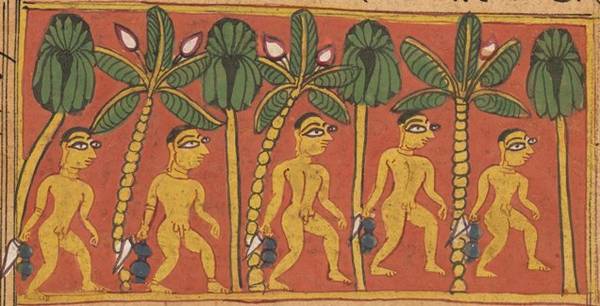
Digambara monks walking
Image by Wellcome Trust Library © Wellcome Library, London
Jain ascetics also are known for their wandering lifestyle – vihāra. Expected to travel around instead of staying in one place as householders do, monks and nuns may cover up to around 30 kilometres a day. This ‘wandering’ – vihāra – entails walking from one place to another every day or every few days. This custom may also be linked to the vow of non-attachment.
Mendicants wander all the time except during the annual rainy season, when they remain in one place for these four months. There are three principal reasons for this practice. Firstly, travelling is difficult because of floods, poor roads and so on, especially as mendicants traditionally travel on foot. Secondly, it reduces the likelihood of breaking the first vow of non-violence, because the warmth and humidity of the monsoon season result in a great increase in various forms of life. Last, while the monks and nuns stay in one place they have more contact with lay people. This encourages devotion among the local lay community.
Daily activities
Every day monks and nuns perform certain tasks. The most important from a practical point of view is probably seeking alms. From a religious viewpoint the most significant is the six rituals – āvaśyaka – ‘necessary, required’.
Other tasks are practical, such as washing garments, where these are worn, or religious, such as memorising or studying sacred writings. These duties vary according to the monastic order, the place of an ascetic within this order, the sex of the mendicant, age and other factors.
Gathering alms
Jain mendicants are not allowed to cook food themselves. They are also not allowed to get it cooked by anybody in the premises where they stay. Thus they have to go to lay people’s houses to get food. The alms tour takes place twice a day for Śvetāmbara mendicants, once in the morning, and once in the afternoon. Digambara ascetics seek alms once a day.
Finding correctly offered alms that are suitable may take hours. However, all food has to be eaten before sunset.
Six daily obligatory rituals
The six rituals each mendicant is supposed to complete every day are known as āvaśyaka – ‘necessary, required’. The most important is the ritual of repentance – pratikramaṇa – which takes place at regular periods, at least twice a day.
Clothing or nudity

Digambara monks and novices
Image by Takeo Kimiya © Takeo Kimiya
This has become the most obvious way to tell the difference between Śvetāmbara and Digambara mendicants. Śvetāmbara means ‘white-clad’ while the latter means ‘sky-clad’ – that is, naked.
However, not all Digambara mendicants go without clothes. Only those who are full mendicants go completely nude because it is considered part of being able to renounce all possessions and have no attachment to anything. Neither male novice mendicants nor nuns go nude. Among the Jains, nudity produces great respect because only those who are capable of full detachment from worldly matters can practise it in total freedom.
In early Śvetāmbara scriptures, there is some flexibility regarding the connection of clothes to the idea of non-possession. As suggested by their name, Śvetāmbara monastic robes are white. In Western Indian manuscript paintings of the medieval period, the robe of the Śvetāmbara mendicants is depicted as white or transparent with white dots. In later times, the robe is simply shown as white, as it is today.
Fasting unto death
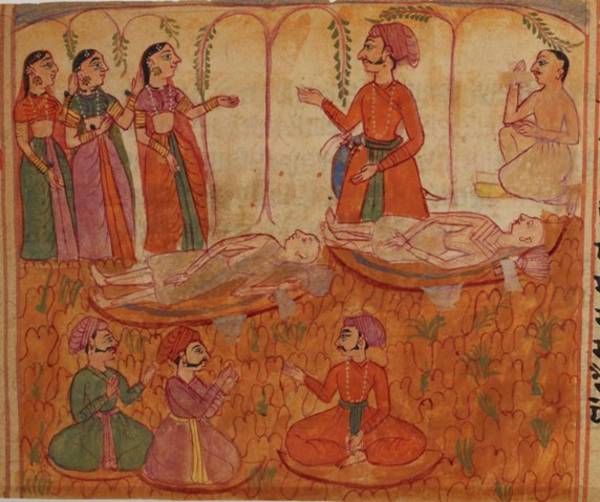
Dhanya and Śālibhadra fast unto death
Image by British Library © CC0 1.0 (Creative Commons Public Domain)
For Jains the conditions of someone’s death are important because the individual’s mental state at this time helps determine destiny in the next birth. For this reason and also because one should avoid living in circumstances that prevent keeping vows or obligations, it is traditional for Jains to try to exercise control over their deaths. It is especially achieved by mendicants as part of ideal ascetic conduct.
The ultimate method of having some control over one’s death is that of sallekhanā – literally ‘thinning out’ – or anaśana, which means ‘fasting unto death’. It implies gradually giving up food and liquids in order to purify the mind and destroy all negative karma and passions. Fasting to death is not considered to be suicide, which is forbidden in Jain belief. A Jain freely chooses the ‘sage’s death’, which is recognised as a difficult choice and is honoured as an expression of devotion.
The mendicant who makes this decision generally goes to a secluded place on a hilltop. Inscriptions and memorials found in places such as Śravaṇa Beḷgoḷa are evidence of this longstanding practice. It is still part of the mendicant’s life today, especially among Digambaras, and is considered to be remarkable and worthy of great respect.
Number of monks and nuns
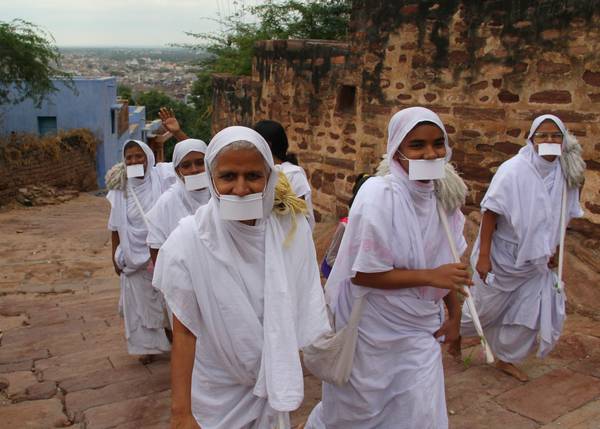
Śvetāmbara Sthānaka-vāsin or Terā-panthin nuns
Image by arjunstc – Arjun © CC BY-NC-ND 3.0
Though the ‘fourfold community’ of the Jains is composed of monks, nuns, lay men and lay women, the proportion of mendicants to laity is likely to have always been very small. A large lay community is probably needed to support a relatively low number of monks and nuns. Estimates of the number of Jains in the world vary from around 5 to 10 million, concentrated in India.
Nearly all Jain monks and nuns are in India because attitudes towards modernity, especially transportation, stop them travelling to Jains outside the country. This results in a handful of mendicants tending to the spiritual needs of over 100,000 lay members of the Jain diaspora. These are chiefly Śvetāmbara Terāpanthin samaṇas and samaṇīs, who are special categories of mendicants permitted to travel, established in 1980 by Ācārya Tulsī.
This table shows the number of Jain monks and nuns in 1999, which is when the figures were last verified.
|
Total mendicants |
Proportion of mendicants (%) |
|||
|---|---|---|---|---|
|
Śvetāmbara Mūrti-pūjak |
1489 |
5354 |
6843 |
58.30 |
|
Śvetāmbara Sthānaka-vāsin |
533 |
2690 |
3233 |
27.46 |
|
Terāpantha |
154 |
557 |
711 |
6.06 |
|
610 |
350 |
960 |
8.18 |
Adapted slightly from the table in the article by Peter Flügel, ‘Demographic Trends in Jaina Monasticism’ in Studies in Jain History and Culture, edited by P. Flügel, London, Routledge, 2006.
Reading
- History of Jaina Monachism from Inscriptions and Literature
Shantaram Bhalchandra Deo - Deccan College Dissertation series; volume 17
Deccan College Postgraduate and Research Institute; Pune, Maharashtra, India; 1956
- The Jains
Paul Dundas - Library of Religious Beliefs and Practices series; series editor John Hinnels and Ninian Smart; volume 14
Routledge Curzon Press; London, UK; 2002
- Escaping the World: Women Renouncers among Jains
Manisha Sethi - South Asian History & Culture series; volume 8
Routledge Taylor & Francis Group; London, UK and New Delhi, India; 2011
- Historical Dictionary of Jainism
Kristi L. Wiley - Historical Dictionaries of Religions, Philosophies, and Movements series; series editor Jon Woronoff; volume 53
Scarecrow Press; Maryland, USA; 2004
Links
- Terāpanthin monks and nuns
-
This YouTube video shows Śvetāmbara Terāpanthin monks and nuns walking down a street in New Delhi in July 2009. Clad in white and wearing the mouth cloth – muṃhpatti – they walk barefoot, carrying their monastic equipment in bags and bundles. They are accompanied by lay Jains, many of the women dressed in orange, which is a holy colour in India. Among the monks is Ācārya Mahāprajña, the tenth ācārya or leader of the sect, who died in May 2010.
- Two Śvetāmbara Terāpanthin samaṇī nuns
-
This YouTube video dating from 2009 shows two Śvetāmbara Terāpanthin samaṇīs tallking about their religious background and beliefs. They hold folded cloths in front of their mouths while they speak. Normally Śvetāmbara Terāpanthin monks and nuns wear a mouthcloth – muṃhpatti – permanently over their mouths, hanging from strings over the ears. Samaṇīs have important roles in teaching the Jain diaspora.
- Five Great Monastic Vows
-
Pravin K. Shah writes about the Five Great Vows taken by Jain monks and nuns. The information is provided by the Jainism Literature Center, associated with the Faculty of Arts and Sciences at Harvard University.
http://www.fas.harvard.edu/~pluralsm/affiliates/jainism/jainedu/5greatvows.htm
- Introduction to Jainism – part 1
-
This extract from a BBC documentary called The Frontiers of Peace introduces the ancient Indian religion of Jainism. A Śvetāmbara monk explains some of the main principles of Jainism, especially non-violence. The programme mentions the influence of Jains in India and on the work of Mahātma Gandhi. This 2010 YouTube video is the first of four parts. See the next part at: http://www.youtube.com/watch?v=UHMQRmRKh_U
- Introduction to Jainism – part 2
-
This extract from a BBC documentary called The Frontiers of Peace explores the relationship between Jain traditions and modernity. A Jain lay man tells how he reconciles his faith with his industrial business interests. A Śvetāmbara monk explains the significance of his monastic broom – known as a rajoharaṇa or oghā – including the eight auspicious symbols wrapped around the handle. A nun leads lay followers in the rite of confession – pratikramaṇa. A young woman creates auspicious symbols in rice as an offering as she talks about her decision to become a nun. This 2010 YouTube video is the second of four parts. See the next part at: www.youtube.com/watch
- Introduction to Jainism – part 3
-
This extract from a BBC documentary on Jainism called The Frontiers of Peace explores the concept of renunciation. The video follows a young woman's decision to become a nun and a rich lay man's faith. The ritual of keśa-loca is filmed, in which monks and nuns pull out their hair. The lay man is shown making the auspicious symbols of the svastika, three dots representing the 'three jewels' of right insight, right knowledge and right conduct and the horizontal crescent of the siddha-śilā, where liberated souls live. This 2010 YouTube video is the third of four parts. See the next part at: http://www.youtube.com/watch?v=670KFhISeUk
- Introduction to Jainism – part 4
-
This extract from a BBC documentary called The Frontiers of Peace explores the mendicant element of the traditional fourfold community. A man talks about his decision to stop being a Jain monk and return to the householder life, while a young woman fulfils her wish to becomes a nun. This 2010 YouTube video is the last of four parts. See the first part at: http://www.youtube.com/watch?v=IPscKFV5yKU
- Digambara monk takes alms from lay women
-
This video on YouTube shows a Digambara monk eating alms offered by lay women. The women gather round and put spoonfuls of food into his cupped hands. He moves his thumbs quickly through it to ensure it is pure enough to eat.
- Śruta-pañcamī – part 2
-
The procession of holy texts in the annual Digambara festival of knowledge – Śruta-pañcamī – is the main subject of this YouTube video. As the centre of festivities, the sacred books are decorated with flower garlands. They are placed on a model elephant, protected from the sun by a canopy and fanned with fly-whisks, all symbols of royalty. The Jain flag is waved in front. Lay Jains, many dressed in orange – the colour of spirituality in India – take part in the noisy procession. Some carry the metal sculptures of the 12 dreams of a Jina’s birth. A nude monk, holding his peacock-feather broom, and white-clad nuns also participate. The procession ends with a display of holy books, the reflection of which is ritually anointed, and a rite of worship in which the auspicious symbol of the svastika can be clearly seen.
This three-part YouTube video records the festival at Mudalur, Tamil Nadu in India, held over 28th and 29th May 2009. This is the second part and you can watch the last part at: http://www.youtube.com/watch?v=zR21K-vcp5U
- Nemi decides to renounce
-
This illustrated page from a 15th-century manuscript of the Kalpa-sūtra is provided by the National Gallery of Australia. At the beginning of the section dealing with the 22nd Jina, Ariṣṭanemi, also called Nemi, the painting shows the famous episode of Prince Nemi's decision to renounce worldly life just before his wedding. He is so appalled by the distress of the animals due to be killed for his wedding feast that he decides to become a monk.
http://artsearch.nga.gov.au/Detail-LRG.cfm?View=LRG&IRN=147981&PICTAUS=TRUE
- Digambara nuns pluck out their hair
-
In the keśa-loca rite, part of the renunciation ceremony of dīkṣā, new monks and nuns pull out their hair, which indicates indifference to worldly concerns, including pain. Ashes are smeared on the roots of the hair, making it easier to pluck out and reducing pain. In the Digambara sects, keśa-loca is a public ceremony. This rite took place among Digambara nuns, as shown by the peacock-feather broom – piñchī – one of them holds in this YouTube video. The dīkṣā was conferred by the nun Gaṇinī Āryikā Viśuddhamati mātājī in Kota, Rajasthan, a few years ago, though the precise date is unknown. The language used is Hindi, with Sanskrit and Prakrit for recitations from the scriptures.
- Śvetāmbara initation candidates in the crowd
-
As part of the renunciation ceremony to become a monk or nun – dīkṣā – the initiation candidates pass through a joyful crowd, who throw sandalwood powder over them. The initiates have already shaven and plucked out their hair and wear the white monastic robe of Śvetāmbara mendicants. This undated ceremony on YouTube takes place in Gujarat.
- Jain mantras
-
This 2007 animation from YouTube features a Digambara monk singing the fundamental Jain sacred formulas. The second is the Namaskāra-mantra, also called the Navkār-mantra or Namokār-mantra. A very old mantra in Prakrit, it can be sung to various melodies. It is chanted daily to the 'five types of beings worthy of worship' or Supreme Beings':
- enlightened teachers – Arhats or Jinas
- liberated souls – siddhas
- mendicant leaders – ācāryas
- teachers – upādhyāyas
- mendicants – sādhus.
Then comes a short mantra about the emptiness of the world of rebirths and the celebration of the 'four auspicious things' or 'four refuges':
- Arhat
- siddha
- monks
- law – dharma.
- Hymn to Naminātha
-
This 2007 hymn on YouTube is a Sanskrit stotra to the 21st Jina, Naminātha or Lord Nami. The sound is accompanied by pictures of statues of Jinas and monks of various Jain sects. The plain statues of nude Jinas with closed eyes and the naked monks belong to Digambara sects. The white-robed mendicants are Śvetāmbara Mūrtipūjakas. The monks and nuns with mouth-cloths attached to their ears are from either the Terāpanthin or Sthānaka-vāsīn Śvetāmbara sects.
- +
- aAbhavya
- aAbhinandana
- aAbhiṣeka
- aĀcāra
- aĀcārāṅga-sūtra
- aĀcārya
- aAchalbhrata
- aAḍhāī-dvīpa
- aAdharma
- aAdho-loka
- aAdhyayana
- aAdvaita Vedānta
- aĀgama
- aAghātīya
- aAghātīya-karman
- aAgnibhuti
- aAgra
- aĀhāra
- aAhiṃsā
- aAhimsa Day
- aAjita
- aAjīva
- aAkampit
- aĀkāśa
- aAkbar the Great
- aAkṣaya-tṛtīyā
- aAlauddin Khalji
- aAlbert Einstein
- aAllah
- aAlms
- aĀlocanā
- aAloka-ākāśa
- aAmāri
- aAmbikā or Kūṣmāṇḍinī
- aAnagāra
- aAnanta
- aAnarthadaṇḍa
- aAnaśana
- aAnekānta-vāda
- aAṅga
- aAniconism
- aAnojjā
- aAntarāla
- aAntarāya-karma
- aAṇu
- aAṇu-vrata
- aAnukampā
- aAnuprekṣā
- aAnusvāra
- aApabhraṃśa
- aAparigraha
- aAra
- aĀrambha
- aĀrambhaja
- aĀratī
- aArdhamāgadhī Prākrit
- aArhaṃ
- aArhat
- aArśana-āvaraṇīya-karma
- aĀrta-dhyāna
- aĀryikā
- aĀryikā Jñānamati
- aĀśātanā
- aĀścarya
- aAscetic
- aAsceticism
- aAshram
- aAspiration
- aĀsrava
- aAṣṭa-maṅgala
- aAṣṭāpada
- aAstikāya
- aAstrolabe
- aAsura
- aAtheism
- aAticāra
- aAtiśayakṣetra
- aAtithisaṃvibhāgavrata
- aĀtma-vāda
- aĀtman
- aAuṃ
- aAurangzeb
- aAuspicious
- aAusterity
- aAvadhāna
- aAvadhi-jñāna
- aĀvaraṇī-yakarman
- aAvasarpiṇī
- aAvatāra
- aAvidyā
- aAxiom
- aĀyāga-paṭa
- aĀyambil
- aĀyu-karma
- aĀyurveda
- bBabur
- bBāhubali
- bBaladeva
- bBālāvabodha
- bBandha
- bBasadi
- bBazaar
- bBhadrankarvijay
- bBhagavant
- bBhaktāmara-stotra
- bBhakti
- bBhale
- bBharata
- bBhāṣā
- bBhāṣya
- bBhaṭṭāraka
- bBhāva
- bBhāva-pūjā
- bBhāvanā
- bBhavana-vāsin
- bBhavya
- bBhavyatva
- bBhaya
- bBhoga-bhūmi
- bBhogopabhoga
- bBodhi
- bBollywood
- bBrahmā
- bBrahma-deva
- bBrahmacārī
- bBrāhmaṇa
- bBraj Bhāṣā
- bBright fortnight
- bBritish Raj
- bBuddha
- bBuddhi-sagar
- bBuddhism
- bBuddhist
- cCaitya
- cCaityavāsin
- cCakravartin
- cCakreśvarī
- cCāmara
- cCandanā
- cCandragupta
- cCandraprabha
- cCanon
- cCāritra
- cCāritramohanīya-karman
- cCarũrī
- cCaste
- cCaturvidha-saṅgha
- cCaturviṃśati-stava
- cCāturyāma
- cCE
- cCelibacy
- cCha
- cChadmastha
- cChastity
- cCheda-sūtra
- cChristian
- cChristianity
- cClergy
- cCloning
- cColophon
- cCommentary
- cConch
- cConfession
- cCongregation
- cConsecration
- cCosmology
- cCremation
- cCrore
- cCult
- cCūrṇi
- dDādā-guru
- dDalit
- dDāna
- dDaṇḍa
- dDark fortnight
- dDarśana
- dDarśanamohanī-yakarman
- dDaśa-lakṣaṇa-parvan
- dDeity
- dDelhi Sultanate
- dDerāsar
- dDeśāvakāśika-vrata
- dDetachment
- dDevanāgarī
- dDevānandā
- dDevarddhi-gani
- dDevotee
- dDhamal
- dDhanuṣ
- dDhāra
- dDharma
- dDharma-dhyāna
- dDharma-sāgara
- dDharmastikaya
- dDhātakīkhaṇḍa
- dDholak
- dDhyāna
- dDiaspora
- dDig-vrata
- dDigambara
- dDīkṣā
- dDisciple
- dDīvālī
- dDivya-dhvani
- dDNA
- dDoctrine
- dDogma
- dDonor
- dDoṣa
- dDravya
- dDravya-pūjā
- dDrone
- dDuṣamā
- dDuṣamā-duṣamā
- dDuṣamā-suṣamā
- dDveṣa
- dDvīpa
- eEast India Company
- eEightfold Path
- eEkānta-vāda
- eEkendriya
- eElder
- eElders
- eEschatology
- eEtc up to
- fFarmān
- fFast
- fFatehpur Sikri
- fFestival
- fFestschrift
- fFiruz Shah
- fFly-Whisks
- fFolio
- fFour Noble Truths
- gGaccha
- gGaṇa
- gGaṇadhara
- gGanadharavada
- gGaṇeśa
- gGaṇin
- gGarba
- gGarbha
- gGarbha-gṛha
- gGaruḍa
- gGati
- gGene
- gGenomics
- gGhātī-yakarman
- gGhātīya
- gGhaznavid
- gGhiyasuddin Tughlaq
- gGhurid
- gGloss
- gGotra-karma
- gGujarāt
- gGujarati
- gGuṇa
- gGuṇa-sthāna
- gGuṇa-vrata
- gGupti
- gGuru
- gGuruṇī
- hHagiography
- hHajj
- hHaṃsa
- hHaribhadra
- hHariṇaigameṣin
- hHasta
- hHeresy
- hHiṃsā
- hHindi
- hHindu
- hHinduism
- hHīravijaya
- hHoroscope
- hHrīṃ
- hHumayun
- hHymn
- iIconoclasm
- iIconography
- iIdol
- iIndian Independence
- iIndology
- iIndra
- iIndrabhūti Gautama
- iIndriya
- iInitiation
- iIntercession
- iInvocation
- iIQ
- iIslam
- iIslamicate
- iIṣṭadevatā
- iĪśvara
- jJagat
- jJahangir
- jJain
- jJaina Devanāgarī
- jJaina Śaurasenī
- jJaina-dharma
- jJainaśāsana
- jJainness
- jJaisalmer
- jJamāli
- jJambū-dvīpa
- jJames Burgess
- jJanma
- jJanma-kalyāṇa
- jJarā
- jJāti
- jJina
- jJina-āgama
- jJina-bhavana
- jJina-bimba
- jJina-mātā
- jJinacandra-sūri
- jJinadatta
- jJinaprabha
- jJīva
- jJñāna
- jJñāna-āvaraṇīya-karma
- jJñāna-āvarṇiya
- jJñānsundar
- jJyotiṣka
- kKāla
- kKālakācārya-kathā
- kKālidāsa
- kKalpa-sūtra
- kKalpa-vṛkṣa
- kKalyāṇaka
- kKalyanvijay
- kKamaṇḍalu
- kKamaṭha
- kKarma
- kKarma-bhūmi
- kKarma-grantha
- kKarma-prakṛti
- kKarma-vāda
- kKarmon
- kKarnataka
- kKaṣāya
- kKathā
- kKāvya
- kKāya
- kKāyotsarga
- kKeśa-loca
- kKetu
- kKevala-jñāna
- kKevalin
- kKhalji
- kKharatara-gaccha
- kKnowledge
- kKriyā
- kKriyā-vāda
- kKṛṣṇa
- kKṣamā-śramaṇa
- kKṣapakaśreṇi
- kKṣatriya
- kKṣullaka
- kKulakara
- kKundakunda
- kKunthu
- lLabdhi
- lLaity
- lLakh
- lLāñchana
- lLands of Action
- lLaukāntika
- lLavaṇa-samudra
- lLeśyā
- lLiṅga
- lLinguistics
- lLoka
- lLoka-ākāśa
- lLoka-puruṣa
- lLoka-vāda
- lLotus
- lLotus lake
- mMadhya-loka
- mMahā-videha
- mMahā-vrata
- mMahābhārata
- mMahāmastakābhiṣeka
- mMāhārāṣṭra
- mMāhārāṣṭrī Prākrit
- mMahattarā Yākinī
- mMahāvīr Jayantī
- mMahāvīra
- mMakāra
- mMakkhali Gośāla
- mMalli
- mMāna-stambha
- mManaḥ-paryāya-jñāna
- mMaṇḍala
- mMaṇḍapa
- mMandit
- mMaṅgala
- mMantra
- mMantras
- mManuṣya-loka
- mMarāṭhī
- mMārgaṇā
- mMartyr
- mMarudevī
- mMaṭha
- mMati-jñāna
- mMauryaputra
- mMecca
- mMendicant lineage
- mMetarya
- mMiracle
- mMithyādṛṣṭi
- mMohandas Gandhi
- mMohanīya-karma
- mMokṣa
- mMonastic order
- mMonasticism
- mMonk
- mMonotheism
- mMosque
- mMount Meru
- mMount Sammeta
- mMṛgāvatī
- mMughal
- mMuhammad
- mMuhammad bin Tughlaq
- mMuhpattī
- mMūla-sūtra
- mMūlaguṇa
- mMumbaī
- mMuni
- mMunisuvrata
- mMurad Bakhsh
- mMūrti-pūjaka
- mMuslim
- mMysticism
- nNābhi
- nNāga-kal
- nNāgapurīya Tapā-gaccha
- nNāgarī
- nNāma-karma
- nNamaskāra-mantra
- nNami
- nNandīśvara-dvīpa
- nNandivardhana
- nNandyāvarta
- nNāraka
- nNāraki
- nNasalisation
- nNātha
- nNavrātrī
- nNaya-vāda
- nNemi
- nNidāna
- nniggaṃthāṇa vā 2
- nniggaṃtho vā 2
- nNigoda
- nNihnava
- nNikṣepa
- nNirgrantha
- nNirjarā
- nNirvāṇa
- nNiryukti
- nNiṣidhi
- nNitya
- nNiyati
- nNo-kaṣāya
- nNudity
- nNun
- oOcean of milk
- oOmniscience
- oOrdination
- ppa°
- pPadmaprabha
- pPadmāsana
- pPadmāvatī
- pPādukā
- pPalanquin
- pPalette
- pPañca-muṣṭi
- pPāṇḍava
- pPaṇḍit
- pPandit Dalsukh D. Malvania
- pPandit Sukhlalji
- pPāṇipātra
- pPāpa
- pParamātman
- pParameṣṭhin
- pPāraṇā
- pParigraha
- pPariṇāma
- pParīṣaha
- pParokṣa
- pPārśva
- pPārśvanātha
- pParyāya
- pParyuṣaṇ
- pPaṭa
- pPatan
- pPātra
- pPenance
- pPersian
- pPhala
- pPhilology
- pPicchikā
- pPilgrimage
- pPīr
- pPolymath
- pPoṣadha
- pPossession
- pPothī
- pPrabhas
- pPradakṣiṇā
- pPradeśa
- pPrākāra
- pPrakīrṇaka-sūtra
- pPrākrit
- pPramāda
- pPramukhā
- pPrati-vāsudeva
- pPratikramaṇa
- pPratimā
- pPratiṣṭhā
- pPratyākhyāna
- pPratyakṣa
- pPravacana
- pPrāyaścitta
- pPrayer
- pPre-modern
- pPreach
- pPredestination
- pProtestant
- pProvenance
- pPudgala
- pPūjā
- pPujārī
- pPukharavara-dvīpa
- pPuṇya
- pPūrva
- pPuṣkara-dvīpa
- pPuṣpadanta
- pPyre
- qQur’an
- rRāga
- rRāhu
- rRainy season
- rRajasthan
- rRajasthani
- rRājimatī
- rRajoharaṇa
- rRajput
- rRāma
- rRāmāyaṇa
- rRangoli
- rRās-garbā
- rRasa
- rRathanemi
- rRatna-traya
- rRātri-bhojana
- rRaudra-dhyāna
- rRecto
- rRelic
- rRenunciation
- rRetroflex
- rRevatī
- %Ṛg-veda
- rRite
- rRosary
- %Ṛṣabha
- %Ṛṣabhanātha
- rRupee
- sSaciyā Mātā
- sSādhu
- sSādhvī
- sSāgāra
- sSaint
- sŚaivaism
- sŚaka-saṃvat
- sSallekhanā
- sŚalya
- sSamacatuṣṭha
- sSamādhimaraṇa
- sSamaṇi
- sSāmarambha
- sSamavasaraṇa
- sSāmāyika
- sSaṃbhava
- sSamiti
- sSaṃjñā
- sSaṃkalpaja
- sSaṃsāra
- sSamudghāta
- sSaṃvara
- sSaṃvega
- sSamyak-cāritra
- sSamyak-darśana
- sSamyak-jñāna
- sSamyaktva
- sSaṃyama
- sSanctuary
- sSandalwood
- sSaṇgha
- sSanskrit
- sSant
- sŚānti
- sSapta-bhaṅgi-naya
- sSārambha
- sSarasvatī
- sSarvajña
- sSāsan-devi
- sŚāsana-devatā
- sŚāstra
- %Ṣaṭ-jīvanikāya
- sSatī
- sSatīmātā
- sSatya
- sSchism
- sScribe
- sScripture
- sSect
- sSecularism
- sŚenāī
- sSermon
- sŚeṣavatī
- sSevā
- sSeven fields of donation
- sShah Jahan
- sShantidas Jhaveri
- sShrine
- sSiddha
- sSiddha-śilā
- sSiddhacakra or Navadevatā
- sSiddhānta
- sSiddhārtha
- sSiddhi
- sSikh
- sSikhism
- sŚikṣā-vrata
- sŚīla
- sSin
- sSindh
- sŚītala
- sŚiva
- sSkandha
- sSomanatha
- sŚraddhā
- sŚramaṇa
- sŚrāvaka
- sŚrāvakācāra
- sŚrāvikā
- sŚreyāṃsa
- sŚrī
- sŚrīvatsa
- sŚruta-jñāna
- sŚruta-pañcamī
- sSthānaka-vāsin
- sSthāpanācārya
- sSthāvara
- sSthavira
- sSthiti
- sStrīmukti
- sStūpa
- sSubcontinent
- sSudarshana
- sŚuddhi
- sSudharma
- sŚūdra
- sSufism
- sSukha
- sŚukla-dhyāna
- sSulasā
- sSultan
- sSumati
- sSundarśrī
- sSupārśva
- sSūri
- sSuṣamā
- sSuṣamā-duṣamā
- sSuṣamā-suṣamā
- sSūtra
- sSuyam me ausam! Tenam bhagavaya evamakkhayam
- sSvādhyāya
- sSvāhā
- sSvastika
- sŚvetāmbara
- sŚvetāmbara Terāpanthin
- sŚvetāmbaras
- sSwan
- sSyād-vāda
- tTabla
- tTantra
- tTapā-gaccha
- tTapas
- tTāraṇ Svāmī Panth
- tTattva
- tTattvārtha-sūtra
- tTemple
- tTemple-city
- tThe Enlightenment
- tTheology
- tThree worlds
- %Ṭīkā
- tTilaka
- tTīrtha
- tTīrthaṃkaranāma-karman
- tTīrthankara
- tTransliteration
- tTrasa
- tTrasa-nāḍī
- tTriśalā
- tTriṣaṣṭi-śalākā-puruṣa-caritra
- tTti bemi
- tTughlaq
- tTunk
- uUdumbara
- uUniversal History
- uUpādhyāya
- uUpāṅga
- uUpaniṣads
- uUpāsaka
- uUpasarga
- uUpāśraya
- uŪrdhva-loka
- uUtsarpiṇī
- uUttarādhyayana-sūtra
- vVāhana
- vVaimānika
- vVairāgya
- vVaiṣṇava
- vVaiśramaṇa
- vVaiśya
- vValabhī
- vVanaspatikāya
- vVandana
- vVaṇik
- vVarṇa
- vVāsudeva
- vVāsupūjya
- vVayubhūti
- vVeda
- vVedanīya-karma
- vVegetarianism
- vVehicle
- vVernacular
- vVerso
- vVidyā
- vVidyā-devī
- vVihāra
- vVijñapti-patra
- vVikrama-saṃvat
- vVikṛti
- vVimala
- vVinaya
- vVipāka
- vVirji Vora
- vVirodhaja
- vVīrya
- vVisarga
- vViṣṇu
- vVītarāga
- vVizier
- vVotive
- vVow
- vVrata
- vVS
- vVyakta
- vVyantara
- vVyasana
- yYakṣa
- yYakṣī
- yYantra
- yYaśoda
- yYaśovijaya
- yYati
- yYātrā
- yYoga
- yYoginī
- yYojana


